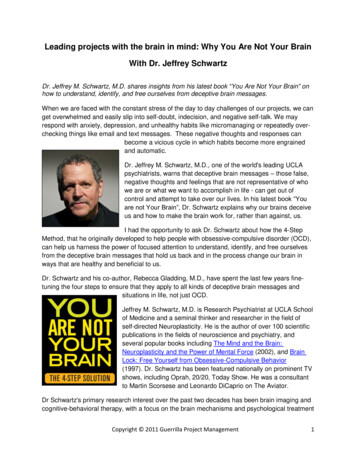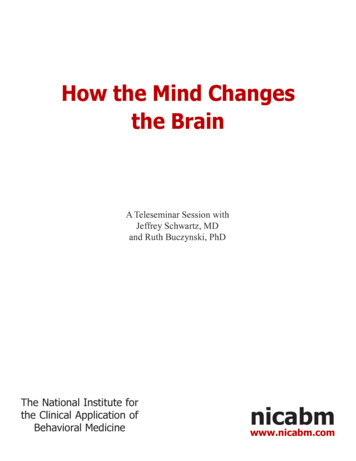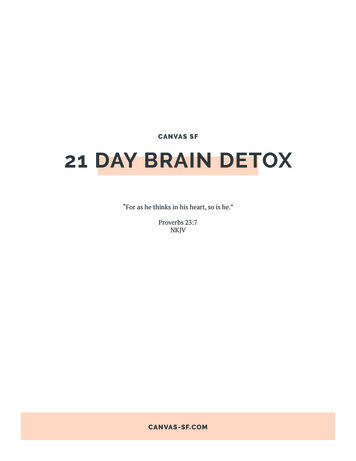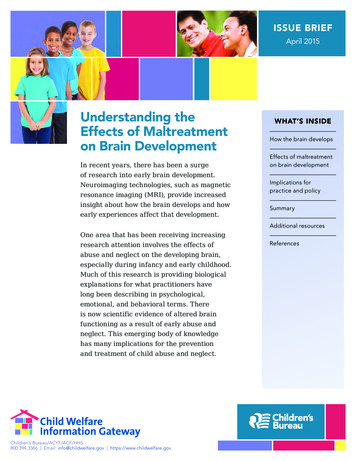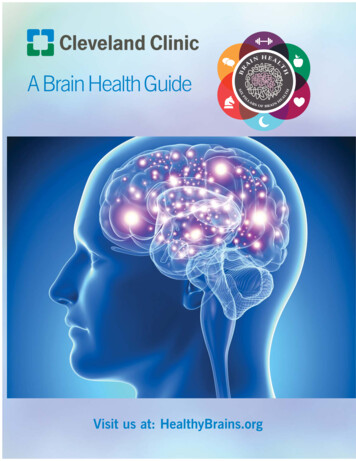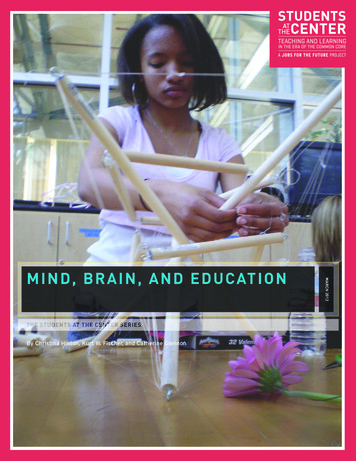
Transcription
By Christina Hinton, Kurt W. Fischer, and Catherine GlennonMARCH 2012M I ND, B R AI N, AND E DUCATIO N
EDITORS’ INTRODUCTION TOTHE STUDENTS AT THE CENTER SERIESStudents at the Center explores the role that student-centered approaches can play to deepen learningand prepare young people to meet the demands and engage the opportunities of the 21st century.Students at the Center synthesizes existing research on key components of student-centered approachesto learning. The papers that launch this project renew attention to the importance of engaging eachstudent in acquiring the skills, knowledge, and expertise needed for success in college and a career.Student-centered approaches to learning, while recognizing that learning is a social activity, pay particularattention to the importance of customizing education to respond to each student’s needs and interests,making use of new tools for doing so.The broad application of student-centered approaches to learning has much in common with othereducation reform movements including closing the achievement gaps and providing equitable access toa high-quality education, especially for underserved youth. Student-centered approaches also align withemerging work to attain the promise and meet the demands of the Common Core State Standards.However, critical and distinct elements of student-centered approaches to learning challenge the currentschooling and education paradigm: Embracing the student’s experience and learning theory as the starting point of education; Harnessing the full range of learning experiences at all times of the day, week, and year; Expanding and reshaping the role of the educator; and Determining progression based upon mastery.Despite growing interest in student-centered approaches to learning, educators have few places towhich they can turn for a comprehensive accounting of the key components of this emerging field. Withfunding from the Nellie Mae Education Foundation, Jobs for the Future asked nine noted research teamsto synthesize existing research in order to build the knowledge base for student-centered approaches tolearning and make the findings more widely available.The topic of this paper, as with each in the series, was selected to foster a deeper, more cohesive,research-based understanding of one or more core elements of student-centered approaches to learning.The authors in this series: synthesize and analyze existing research in their areas; identify what is knownand where gaps remain related to student-centered approaches to learning; and discuss implications,opportunities, and challenges for education stakeholders who put students at the center. The authorswere asked to consider the above definition of student-centered approaches, but were also encouraged toadd, subtract, or critique it as they wished.The authors were not asked explicitly to address the Common Core State Standards. Nevertheless,the research proceeded as discussions of the Common Core were unfolding, and several papers drawconnections with that work. The thinking, learning, and teaching required for all students to reach thepromised outcomes of the Common Core provide a backdrop for this project. The introductory essay looksacross this paper and its companion pieces to lift up the key findings and implications for a new phase inthe country’s quest to raise achievement levels for all young people.The nine research papers are loosely organized around three major areas of inquiry—learning theory;applying student-centered approaches; and scaling student-centered learning—although many of thepapers necessarily cross more than one area:1. LEARNING THEORY: What does foundational and emerging research, particularly in the cognitive andbehavioral sciences, tell us about how students learn and about what motivates them to learn?Mind, Brain, and EducationChristina Hinton, Kurt W. Fischer, Catherine GlennonMotivation, Engagement, and Student VoiceEric Toshalis, Michael J. Nakkula
2. APPLYING STUDENT-CENTERED APPROACHES: How are student-centered approaches to learningimplemented? What is the nature of teaching in student-centered learning environments? How canstudents who are underrepresented in postsecondary education be engaged earlier and perform wellin the math and reading activities that scaffold learning? How are advances in technology customizingcurriculum and changing modes of learning to meet the needs of each student?Teachers at Work—Six Exemplars of Everyday PracticeBarbara Cervone, Kathleen CushmanLiteracy Practices for African-American Male AdolescentsAlfred W. TatumLatino/a and Black Students and MathematicsRochelle Gutierrez, Sonya E. IrvingCurricular Opportunities in the Digital AgeDavid H. Rose, Jenna W. Gravel3. SCALING UP STUDENT-CENTERED APPROACHES TO LEARNING: How have schools soughtto increase personalization and with what outcomes for learning? What is the relationship betweenassessment and student-centered approaches? What can districts do to support student-centeredapproaches to learning?Personalization in SchoolsSusan Yonezawa, Larry McClure, Makeba JonesAssessing LearningHeidi Andrade, Kristen Huff, Georgia BrookeChanging School District PracticesBen Levin, Amanda Datnow, Nathalie CarrierA number of distinguished researchers and practitioners serve as advisors to Students at the Centerincluding Scott Evenbeck, founding president of the New Community College, City University of NewYork; Charles Fadel, Visiting Scholar, Harvard Graduate School of Education, MIT ESG/IAP, and Wharton/Penn CLO; Ronald Ferguson, Senior Lecturer in Education and Public Policy, Harvard Graduate School ofEducation and the Harvard Kennedy School; Louis Gomez, Professor and the John D. and Catherine T.MacArthur Foundation Chair in Digital Media and Learning, Graduate School of Education and InformationStudies, UCLA; Susan Moore Johnson, Professor and the Jerome T. Murphy Professor of Education,Harvard Graduate School of Education; Jim Liebman, Simon H. Rifkind Professor of Law, ColumbiaUniversity School of Law; Miren Uriarte, Professor, College of Public and Community Service, University ofMassachusetts, Boston; and Arthur VanderVeen, Vice President, Business Strategy and Development atCompass Learning.To download the papers, introductory essay, executive summaries, and additional resources, please visitthe project website: www.studentsatthecenter.org.Over the coming months, Jobs for the Future and the Nellie Mae Education Foundation will craftopportunities to engage a broad audience in the conversation sparked by these papers. We look forward tobuilding a shared understanding and language with you for this important undertaking.Nancy Hoffman, Adria Steinberg, Rebecca WolfeJobs for the Future
Jobs for the Future identifies, develops, and promotes education and workforce strategies that expandopportunity for youth and adults who are struggling to advance in America today. In more than 200communities across 43 states, JFF improves the pathways leading from high school to college to familysustaining careers.WWW.JFF.ORGThe Nellie Mae Education Foundation is the largest charitable organization in New England that focusesexclusively on education. The Foundation supports the promotion and integration of student-centeredapproaches to learning at the middle and high school levels across New England. To elevate studentcentered approaches, the Foundation utilizes a strategy that focuses on: developing and enhancingmodels of practice; reshaping education policies; increasing the body of evidenced-based knowledgeabout student-centered approaches and increasing public understanding and demand for high-qualityeducational experiences. The Foundation’s initiative and strategy areas are: District Level SystemsChange; State Level Systems Change; Research and Development; and Public Understanding. Since 1998,the Foundation has distributed over 110 million in grants.WWW.NMEFOUNDATION.ORGABOUT THE AUTHORSChristina Hinton, Ed.D., works on issues at the nexus of neuroscience and education at Harvard GraduateSchool of Education. Her recent research focuses on the biological basis of empathy and educationfor a cosmopolitan ethic of care. She has authored many articles and book chapters on educationalneuroscience, and lectures internationally on implications of neuroscience research for education,research schools, and education for global awareness.Kurt W. Fischer, Ph.D., Charles Bigelow Professor of Education and the director of the Mind, Brain,and Education Program at the Harvard Graduate School of Education, studies cognitive and emotionaldevelopment and learning from birth through adulthood, combining analysis of the commonalitiesacross people with the diversity of pathways of learning and development. He is the author of “DynamicDevelopment of Action, Thought, and Emotion” in the Handbook of Child Psychology (Volume 1); HumanBehavior and the Developing Brain; Mind, Brain, and Education in Reading Disorders; and a dozen otherbooks, as well as over 200 scientific articles.Catherine Glennon, Ed.M, earned a Master’s degree from the Mind, Brain, and Education program atthe Harvard Graduate School of Education. She is a cognitive development research specialist at HGSE,researching developmental pathways of perspective taking, complex reasoning, and student engagement.PUBLICATIONcopyright 2012 by Jobs for the Futurecourtesy of Patrick HaymanPHOTOGRAPHY
TABLE OF CONTENTSINTRODUCTION1S T U D E N T- C E N T E R E D L E A R N I N G2HOW THE BRAIN LEARNS3Active Learning5INDIVIDUAL DIFFERENCES6LANGUAGE LEARNING8LITERACY IN THE BRAIN9M AT H E M AT I C S I N T H E B R A I N11EMOTION AND LEARNING13Motivation15Stress15Relationships16I M P L I C AT I O N S F O R S T U D E N T- C E N T E R E D L E A R N I N G A P P R O A C H E S17U n d e r s e r v e d Yo u t h19C h a l l e n g e s a n d Fu t u re D i re c t i o n s19ENDNOTES21REFERENCES22
INTRODUCTIONRecent technological breakthroughs makeneurological mechanism underlying learning. Asresearch in biology and cognitive sciencestudents learn in both formal and informal contexts,more relevant for education than ever before.these experiences shape the physical architecturePowerful brain imaging tools enable neuroscientistsof their brains (Squire & Kandel 2009). The chapterto study the learning brain in action for the firstthen presents neuroscience research on individualtime. New technologies in genetics allow researchersdifferences, which are central to the student-centeredto explore complex gene-environment interactions.learning concept. Since students have differentInnovative cognitive science methods for analyzinggenetic predispositions and experience continuouslylearning enable researchers to track alternativeshapes their brains, each student’s brain has a uniquelearning pathways. These and other advancementsprofile of strengths and limitations (Fischer & Bidellhave led to a global emergence of the field of mind,2006). The paper then describes how the brainbrain, and education (Fischer, Immordino-Yang, &learns certain academic content, including language,Waber 2007; Fischer et al. 2007; OECD 2007; Sternliteracy, and mathematics. Language learning is2005). This field aims to synthesize research indiscussed because one in four low-income studentsbiology, cognitive science, and education to createis an immigrant (NCSL 2004), and proficiency ina trans-disciplinary learning science that can informthe language of instruction strongly influenceseducation policy and practice.academic achievement among immigrants (OECDThis paper considers student-centered learningapproaches in light of mind, brain, and educationresearch.1 Student-centered approaches to learningcomprise a research-based framework for educationthat aims to help students from a wide range ofbackgrounds master the skills necessary for collegeand the 21st-century knowledge economy (JFF 2011).In particular, it is intended to support underservedyouth who are often excluded from higher education.The approaches begin with a common set of rigorousstandards. Students can reach these standardsthrough learning experiences tailored to their needsand interests, which may include informal learningoutside of school. Students are empowered to takeresponsibility for their own learning, with teachers2003). Literacy and mathematics are core academicsubjects, highly relevant for all students. Research onhow these academic abilities are created in the brainillustrates how learning experiences shape the brainand give rise to individual differences. Finally, thepaper explores the fundamental role of emotions inlearning. As part of this, it elucidates the influence ofstress on the brain, which has important implicationsfor education, especially education of underservedyouth who are under the chronic stress of poverty(Shonkoff & Phillips 2000). After this mind, brain, andeducation research is presented, the paper considersthe implications of this work for student-centeredlearning approaches, with a particular focus on usingthese approaches to educate underserved youth.and other professionals as facilitators.While many student-centered learning approachesare well grounded in education research, this paperis the first to consider student-centered learningfrom the perspective of trans-disciplinary researchin mind, brain, and education. This paper beginswith a brief description of the student-centeredlearning concept. It then discusses research inmind, brain, and education that is most relevantto student-centered learning. It first explains theJobs for the Future 1
STUDENT-CENTERED LEARNINGThe student-centered learning model aims tocenters to cyberspace. Likewise, educators canhelp students from all backgrounds masterinclude teachers, parents, community members, andthe skills needed for postsecondary educationprofessionals. The approaches resonate with theand the 21st-century knowledge economy (JFF 2011).Nigerian proverb: It takes a village to raise a child.In this approach, education provides flexible learningStudent learning can—and should—be supported by aexperiences that enable students at various levelsrange of adults in multiple contexts. Moreover, withto build toward mastery of a common set of corethis approach, all learning experiences that build coreskills. A commitment to addressing the individualskills are formally credited.needs and goals of each student is at the core ofthe model. Therefore, students are empowered tofollow customized learning pathways that meettheir particular needs and interests as they buildtheir expertise. As students progress, educatorsuse formative assessment to guide learning andteaching. Formative assessment involves usingongoing assessment throughout the learning processto tailor instruction to meet each student’s currentneeds (OECD 2005). Student-centered learningapproaches recognize each student’s emotional needsas well. Such approaches work to help students buildself-confidence and motivation through learningIn addition, student-centered models call foradvancement upon mastery. Students advance whenthey have reached proficiency in particular skills,rather than when they have accumulated a certainnumber of hours in a classroom. Students thereforedo not necessarily progress with their peers in acohort. Instead, each student is challenged based onher or his skill levels and graduates a program whenhe or she meets that program’s established standards.Overall, student-centered learning approachescompose a flexible system designed to help studentsfrom all backgrounds succeed academically.experiences that match their abilities and interests,with the ultimate goal of supporting them to becomeself-directed learners.Another fundamental element of student-centeredlearning approaches is that learning can take placein both formal and informal contexts. Learning is notrestricted to the confines of a traditional classroomor school hours; rather, it transpires in multipledimensions of a student’s life. Learning can occurin settings ranging from internships to communityStudent-centered learning approaches work to help students build selfconfidence and motivation through learning experiences that match their abilitiesand interests, with the ultimate goal of supporting them to become self-directedlearners.2 Mind, Brain, and Education: The Students at the Center Series
HOW THE BRAIN LEARNSArguably the most important insight forEach neuron has three main parts: dendrites; a celleducation from the field of neuroscience isbody; and an axon (Kaczmarek & Levitan 2002) (seethat the brain is highly adaptive, a propertyFigure 1). When a student has a learning experience,called plasticity (Singer 1995; Squire & Kandelsuch as looking at a painting in an art museum,2009). Students’ brains continuously adapt to thecertain neurons are activated. The dendrites of eachenvironments where they live and work, includingactivated neuron receive chemical signals in responseschool, home, workplaces, community centers, andto this experience. Dendrites then relay these signalsso forth. As students learn in these places—masteringto the cell body, and if the signal is above a certainreading, playing online chess, or practicing typing—threshold, it triggers an electrical signal called anthese experiences gradually sculpt the architectureaction potential. The action potential then travelsof the brain. The brain is made up of networks ofalong the axon, a long process covered by a fattyinterconnecting nerve cells called neurons andmyelin sheath. When an action potential reaches thesupportive glial cells. Learning experiences areend of the axon, it prompts the release of chemicaltranslated into electrical and chemical signals thatsignals into the synaptic cleft, a small space betweengradually modify connections among neurons inneurons. These signals then bind to receptors oncertain areas of the brain. Over time, these changesthe dendrites of downstream neurons. This leadsin neuronal connectivity can aggregate to significantto the series of intercellular signaling describedreorganization of brain areas involved in certain typesabove in these neurons, which in turn stimulatesof learning.other neurons, and so forth. Therefore, a learningexperience elicits a cascade of signaling among manyneurons in many areas of the brain. In fact, readingFIGURE 1A NEURONjust the words in this sentence activates millions ofneurons in the brain.Learning experiences modify connections amongneurons in certain areas of the brain, which graduallyreorganize these areas (Squire & Kandel 2009).Each neuron has many inputs from other neurons.When students have learning experiences, certainconnections are activated, while others are not. Overtime, connections that are most active relative toother inputs are strengthened, while those that arerelatively less active are weakened or eliminated(Hebb 1949; Squire & Kandel 2009). In this way,Source: Adapted from OECD (2007)Students’ brains continuously adapt to the environments where they live andwork. As students learn in these places, these experiences gradually sculpt thearchitecture of the brain.Jobs for the Future 3
connections are gradually modified in response to(Li Voti et al. 2011; McCandliss, Posner, & Givo’n 1997;learning experiences following a “use it or lose it”Ostry, et al. 2010; Shtyrov, Nikulin, & Pulvermüllerrule. These experience-dependent changes in the2010), and learning Braille (Hamilton & Pascual-Leoneefficacy of neuronal connections are thought to be1998).the biological substrate of memory. Over time, theyaggregate to significant reorganization in certainbrain structures, which reflects learning in domainsassociated with those structures.Eleanor A. Maguire and colleagues (2000) revealedplasticity in response to learning in the hippocampus.The hippocampus is an area of the brain knownto play a central role in spatial learning (Maguire,This plasticity is most well researched in the domainBurgess, & O’Keefe 1999; Smith & Milner 1981).of music. Seminal work by Thomas Elbert, ChristoMaguire and colleagues found that London taxiPantev, and their colleagues demonstrated thatdrivers have an enlarged hippocampus relative tolearning to play the violin leads to changes in thecontrol subjects who are not taxi drivers (Maguireorganization of certain areas of the cortex, a brainet al. 2000; Woollett, Spiers, & Maguire 2009).area involved in many types of learning (Elbert etMoreover, the degree of hippocampal enlargemental. 1995; Pantev et al. 1998). Elbert et al. (1995)is correlated with the amount of time spent as a taxishowed that the area of the somatosensory cortexdriver, which suggests that the enlargement is asrepresenting the fingers of the left hand is larger inresult of experience as a taxi driver, rather than aviolinists than in non-musicians. Moreover, this areapreexisting condition that biases certain individuals toof the brain is also larger for violinists’ left handsbecome taxi drivers. As London taxi drivers learn tothan for their right hands. This suggests that thisnavigate the twists and turns of the city’s streets, thisarea is enlarged as a result of practicing the violin,presumably strengthens connections among neuronsrather than, for example, a genetic predisposition forinvolved in spatial processing in the hippocampus,a large somatosensory cortex that could predisposeleading to the observed enlargement.individuals to become violinists. As a studentpractices the violin, neuronal connections in thesomatosensory cortex underlying finger dexterity inthe left hand are activated, which strengthens them.Over time, this likely accounts for the differences inthe somatosensory cortex observed by Elbert andcolleagues.As students learn—in both formal and informalcontexts—these experiences shape the architectureof their brains. Therefore, abilities are not fixedbut rather continuously developing. In essence,the more a student learns in a particular area, themore intelligent the brain becomes in that area.This plasticity enables students to overcome manyLearning to play the violin influences the auditorylearning challenges. For example, some students havecortex as well. Pantev et al. (1998) found that the areadyslexia, a reading difficulty commonly involvingof the auditory cortex representing musical tonesimpaired phonological processing (Lyon, Shaywitz, &is larger in violinists than in non-musicians. This isShaywitz 2003). While this presents a clear learningtrue only for tones of the musical scale, not purechallenge, brain plasticity enables many dyslexictones, suggesting that this area became enlargedstudents develop alternative neural circuitry tothrough musical practice. Moreover, later researchsupport reading when given appropriate educationalshowed that short-term musical training led tosupport (Shaywitz 2003). In fact, brain plasticity canstrengthening of neuronal connections in the auditoryenable students to overcome even severe learningcortex (Pantev et al. 2003). This result supports thechallenges. A case study of a student who had halfnotion that as students practice the violin, neuronalof his brain removed due to severe epilepsy revealsconnections in the auditory cortex are strengthened,the incredible plasticity of the brain (Immordino-Yangwhich eventually leads to large-scale reorganization.2008). A hemisphere of this student’s brain wasResearch has demonstrated this type of plasticity inremoved when he was in preschool, severely impairingthe cortex as a result of other types of learning asa slew of functions. However, the remaining brainwell, including learning other instruments (Lappehemisphere gradually developed to compensate foret al. 2008; Pantev et al. 2003), motor learningthe missing one to a significant degree. Now in high(Ungerleider, Doyon, & Karni 2002), language learningschool, this student is cognitively normal, performing4 Mind, Brain, and Education: The Students at the Center Series
above average in school, maintaining friendships, andthey earned rewards, it led to the expansion of theis an aspiring artist. Crucially, this student receivedareas of the auditory cortex involved in processingextensive educational support that was tailored tothat information. However, when the same auditorysupport his weakness and capitalize on his abilities.stimulation occurred and monkeys passively heard it,The educational environment plays a crucial roleit did not lead to changes in the auditory cortex.in shaping the brain’s abilities and determiningRecent imaging work suggests that cortical plasticitystudents’ academic achievement. Education shouldis conditional upon active engagement in humanstherefore strive to provide learning experiences thatas well (Ruytjens et al. 2006; Weinberger 2008;enable students at all levels to build toward masteryWiner & Schreiner 2011). Complementary researchof a common set of skills, which is a principle ofshows that active engagement is also necessarystudent-centered learning approaches. Researchfor the strengthening of neuronal connections inon brain plasticity also indicates that the brain isthe cortex thought to underlie large-scale corticallearning virtually all of the time, in both formal andreorganization (Ahissar et al. 1992; Recanzone etinformal contexts (Squire & Kandel 2009; OECDal. 1993; Recanzone & Wurtz 2000). Taken together,2007). Education can therefore take advantage ofthis research suggests that active engagement is anontraditional learning experiences in addition toprerequisite for the changes in brain circuitry that areschool, such as afterschool enrichment, internships,thought to underlie learning. In educational terms,and community programs. This approach is integralthis suggests that passively sitting in a classroomto student-centered learning, which formally creditshearing a teacher lecture will not necessarily leadthese types of informal learning experiences.to learning. Conversely, active engagement witheducational material within or outside of school willsupport learning.2ACTIVE LEARNINGNeuroscience research suggests that activeRelated Paper in the Students at the Center Series3engagement is necessary for learning. The changesFor a more detailed discussion of research on activeengagement and learning theory, see Motivation,Engagement, and Student Voice, by Eric Toshalis and MichaelJ. Nakkula.in neuronal connections that underlie learning in thebrain do not seem to occur when learning experiencesare not active. In a seminal experiment, Gregg H.Recanzone and his colleagues (1992) found that whenmonkeys actively attended to finger stimulationbecause it was relevant to their goals, they learnedthe association between the stimulation and theirgoals, and the area of the somatosensory cortexrepresenting the stimulated finger became enlarged.However, when monkeys received the same fingerstimulation passively, it did not lead to changes inthe somatosensory cortex. Researchers found thesame pattern in plasticity of the auditory cortex(Reconzone et al. 1993). When monkeys were activelyengaged in learning auditory information becauseEducation can take advantage of nontraditional learning experiences in additionto school, such as afterschool enrichment, internships, and community programs.Jobs for the Future 5
INDIVIDUAL DIFFERENCESWhy do some students whiz throughor not; rather, it points to a more nuanced perspectivechemistry while others struggle? Whythat recognizes that each student has a complexdo certain students show an uncommonprofile of strengths and limitations.resilience in the face of adversity? Why are somestudents passionate about literature and others drawnto mathematics? These variations are grounded inindividual differences in the brain. Students’ geneticpredispositions interact with learning experiencesto give rise to a wide range of individual differences(Fischer & Bidell 2006; Hinton & Fischer 2011;Shonkoff & Phillips 2000; Ridley 2003). Students areborn with certain genetic tendencies. As they interactwith the world around them, these experiences canreinforce or counteract their genetic inclinations. Forexample, a student may have a genetic predispositionfor shyness (Arbelle et al. 2003), yet grow into aIn fact, recent research suggests that it may be amisnomer to label dyslexia as a disability. Studentswith dyslexia have reading difficulty that resultsfrom atypical cortical organization (Shaywitz 2003).However, recent research suggests that the atypicalcortical organization of dyslexics is also associatedwith specific visual talents (Schnepps, Rose, & Fischer2007). Different brain circuitry underlies the centraland peripheral visual fields. While most studentsprocess visual stimuli most easily in the central visualfield, which is used for reading, dyslexic studentsfavor the peripheral visual field.gregarious person despite that because of supportiveIt turns out that this difference leads to certain visualsocial experiences at home, in school, or in thetalents. Dyslexics are better than non-dyslexics atcommunity.integrating information across the visual field andSince genetics and experience interact to shapethe brain, each student’s brain is unique. Studentshave a collection of different abilities, and a studentmay struggle in one area, such as mathematics,and yet thrive in another, such as interpersonalintelligence (Gardner 1983). Moreover, within eachof these domains, students can have both talentsand limitations. For example, in the musical domain,students who have perfect pitch typically strugglewith transposing, which is singing a melody in a keythat is different from the one it was written in. Mind,brain, and education research does not support thesimplistic notion that each student is either intelligentquickly detecting anomalies or oddities in visualimages (von Karolyi et al. 2003). This is not merelyan interesting laboratory finding—it has real-worldimplications. These visual talents give dysle
biology, cognitive science, and education to create a trans-disciplinary learning science that can inform education policy and practice. This paper considers student-centered learning approaches in light of mind, brain, and education research.1 Student-centered approaches to l



